Text
youtube
COLOSSAL ANCIENT WHALE COULD BE THE HEAVIEST ANIMAL EVER!
Perucetus colossus, an ancient whale that swam off the coast of present-day Peru 39 million years ago, rivals the blue whale as the heaviest animal ever. A blue whale can weigh up to 100-190 tonnes, but the newly described extinct marine mammal weighed between 85 and 340 tonnes, estimate palaeontologists in a study published in the journal Nature.
‘The discovery pushes extreme growth in whales to a much earlier phase in their evolution than previously thought’, says paleontologist and co-author Olivier Lambert from the Royal Belgian Institute of Natural Sciences.
Read more on our website: www.naturalsciences.be
35 notes
·
View notes
Photo




🦅 After ULB's five chicks, it was now the turn of this season's other falcons from Falcons for Everyone to be ringed. 🦅
The Cathedral falcon, the first of the season, is a female! We could tell this from the length of her wings and her weight, but also from the fact that she has rather few feathers. She received two rings on 10 May: an official registration ring from the Royal Belgian Institute of Natural Sciences and a second, special ring, which allows identification from a distance.
After the "growth phase" - she now weighs 28 (!) times her birth weight - this young Peregrine now enters the phase of producing thousands of feathers of all different types. We can't wait to see her transformation in the coming days.
Check it out live 📱 and watch this curious chick walk her little feet along the balcony!
👉 For more details on her development: https://www.falconsforeveryone.be/blog/a-female-falcon-chick-at-the-cathedral
And what about the falcon at the St Job's Church? This spring, a new pair of Peregrine Falcons took over the place of the previous pair. That historic pair had been breeding there since 2015 and raised as many as 29 falcons. Possibly they both died, as Peregrine Falcons are by nature very loyal to their nesting sites ...
This pair of newcomers gave birth to 3 healthy female chicks in their first nest together! They were ringed on Friday 12 May. 🦅
👉 More about the St Job's nesting site here: https://www.falconsforeveryone.be/blog/banding-of-the-falcon-chicks-of-uccle-saint-job
#peregrine falcon#falcons#falcon#brussels#falconsforeveryone#naturalsciences#ornithology#baby birds#wild birds
26 notes
·
View notes
Photo




🦅 Today, the five peregrine falcons chicks (3 females and 2 males) from the ULB have been ringed by our ornithologist Didier Vangeluwe. 🦅
Ringing is an important step in the monitoring and observation of wild birds. In addition to making it possible to recognize these Peregrine falcons if they later return to nest in the capital, ringing primarily ensures the monitoring of the birds’ evolving migratory routes: what migration strategies do they follow as natural areas change, affected by climate change and detoriation?
The ringing of birds also gives the opportunity to take samples that allow to study the dispersal of pathogens (influenza, West Nile), the concentrations of pollutants (heavy metals, pesticides) or genetic relationships.
The collected data make it possible to establish legal rules for the conservation of wild birds.
Learn about the ringing of wild bird populations by BeBirds: https://odnature.naturalsciences.be/bebirds/en/why-ring-birds
And find out more about these Peregrine falcons: https://www.falconsforeveryone.be/
19 notes
·
View notes
Photo

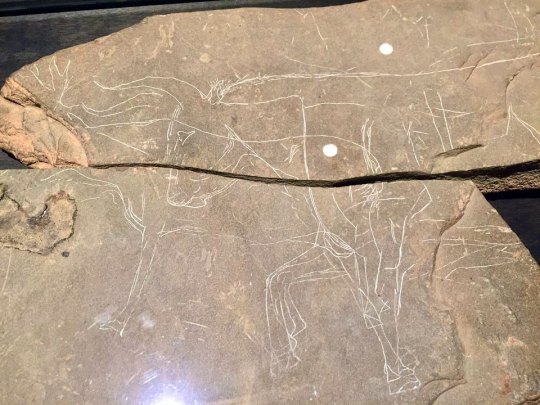



🐂 This is the famous Chaleux stone, one of the biggest pieces of Belgian’s ‘portable art’ (that could be carried from place to place). The slab is part of our collections and exhibited in the Gallery of Humankind.🐂
It was found in the region of Dinant and dates back to 12,000 to 13,000 years ago, from the so-called Magdalenian culture. Think: end of the last glacial period, the extinction of mammoths and Lascaux and Altamira cave art. Portable art was the result of carving or engraving bone, antler, ivory or stone. Some examples, like the Chaleux stone, are the earliest traces of realism in art.
The object also gives us a glimpse of the biodiversity of that period. 🌿
The front side of the slab shows an auroch, an wild ancestor of our modern cattle. Aurochs were among the largest herbivores at that time: a shoulder height of up to 180 cm in bulls, and weighing up to 1300 kilos. It also had massive elongated and broad horns that reached 80 cm in length. This animal must have been an impressive sight! European aurochs went extinct a long time ago due to human activities: habitat loss and over-hunting.
Behind it you can see another animal, with antlers, that already roamed our regions during the Paleolithic : the forest reindeer. During prehistoric times, forest reindeers used to populate multiple regions across western Europe. Contrary to the aurochs, the species survived and is still found in smaller areas of Scandinavian and Karelian forests. 🦌🌲
On the other side of the stone: a wild horse, a standing ibex and one lying down. Can you spot them? 👀 We have scanned Belgian portable art so you can admire them in 3D: paleo-art.naturalsciences.be. There is even an anthropomorphic statuette (a Venus)!
https://paleo-art.naturalsciences.be/
[First picture by visitor @dis_oakenshield on Instagram]
#museum#museumvisitor#chaleuxstone#art#prehistoric art#dinant#belgium#archeology#history#portable art#prehistoric
105 notes
·
View notes
Photo





🦅Good news for the pair of peregrine falcons that nestles at the campus of the ULB: All five eggs laid by the female this year have successfully hatched! 🦅
The first chicks hatched on April 20th and the chirps or cracks in the eggs already indicated that more hatchlings were imminent. Nevertheless, whether all five eggs had been fertilized or properly incubated remained uncertain.
The hatching of five eggs for a peregrine pair is an exceptional situation, but one that involves a lot of “teamwork” from the parents: After tackling the task of keeping these five eggs warm simultaneously, they are now faced with five young to care for and feed. If all goes well, the five young falcons will take their first flight from the belfry in a few weeks!
At St. Jacob's Church in Uccle, the family has also grown. Two out of the four eggs laid by the female of this couple of newcomers have hatched: we are impatiently waiting for the arrival of two more young birds very shortly!
👉 Check out the blog and watch the livestream: https://www.falconsforeveryone.be/blog/hatching-and-exceptional-images-at-the-ulb
44 notes
·
View notes
Photo


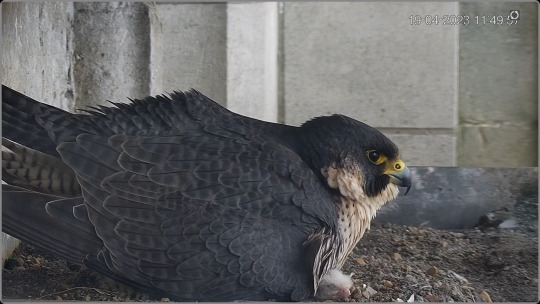

🦅 The single egg of the Peregrine Falcon pair at the Cathedral of Saints Michael and Gudule has hatched on Tuesday 18th of April, in the late afternoon. It is the first hatchling of the year ! A magical moment, but also one of relief, as we had been waiting for its arrival for over a week!
Hatching is a long and exhausting process; the chick is very cramped in the egg and has to rotate on itself to cut the top of the egg, millimeter by millimeter, in order to get out of it. After several hours of work, the young falcon is now resting under its mother's warm duvet: it is ready to enter six decisive weeks for its development, until its first flight out of the nest! 🐣
The next imminent hatching will soon occur at the ULB : we can already hear their first chick chirping in the egg!
👉 Follow the evolution of the falcons through the live camera streaming, pictures and blog posts from IRSNB ornithologist Didier Vangeluwe over here https://www.fauconspourtous.be/
16 notes
·
View notes
Photo
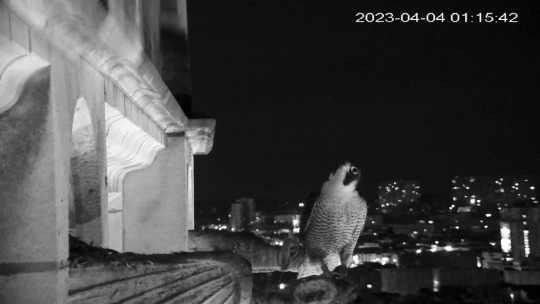




🦅 The 19th edition of Falcons For Everyone is on! 🦅 Spring is well and truly here, and with it, a new nesting season for the peregrine falcons.
During the next few weeks, you can follow the daily lives of three peregrine falcon pairs nesting in Brussels, through the live HD streaming, 24/7, of the cameras placed inside their nests:
🐣 One peregrine couple resides in the Saint Michael and Gudule Cathedral: They only laid one egg this year and it’s expected to hatch around April 10th.
🐣 In the bell tower of the St. Job Church in Uccle, a new couple has settled in and is waiting for their four chicks to hatch around April 17.
🐣 the third couple nests on top of the tower of building A, on the campus of the ULB: the female has laid five eggs that should also hatch around April 17th. An exceptional situation, and a lot of babies to take care of!
Accompany these new parents and witness their young grow, from the little hatchling of 30 grams, up until their first flight as impressive birds who can reach up to one kilogram: You don’t want to miss this!
👉 More news, images and information on the website https://www.falconsforeveryone.be/ and via our Instagram- and Facebook stories in the following weeks.
22 notes
·
View notes
Photo
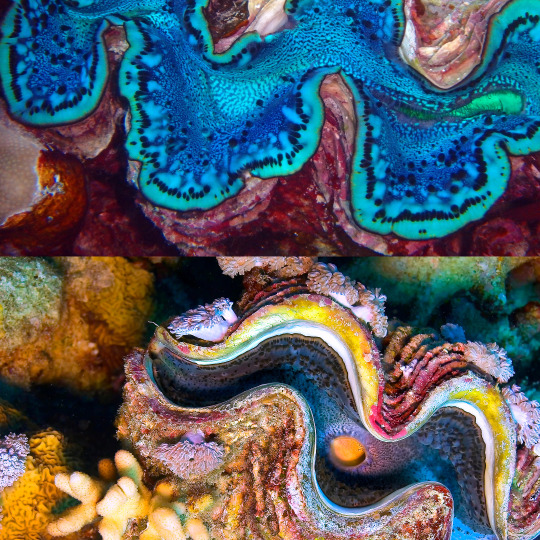
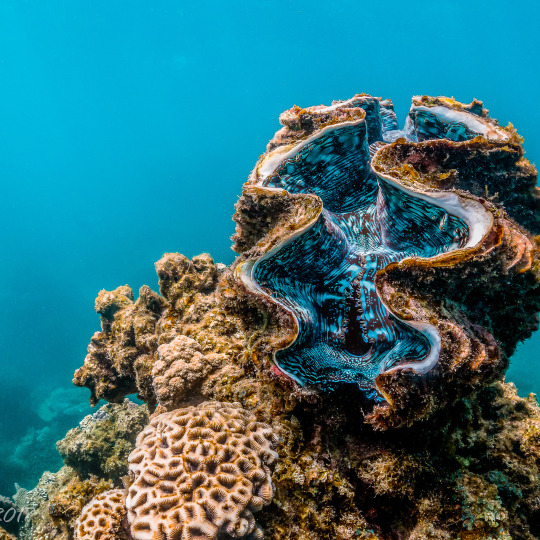


🪸 Meet the Giant Clam (Tridacna gigas)! 🪸
This impressive mollusc is an inhabitant of the ocean floors. It lives in shallow-sunlit waters near coral reefs.
It’s the largest marine bivalve (same group as mussels and oysters), with a shell that can measure up to 1.4 meters at full maturity, weighing up to 250 kilos! #NatureIsTheGreatestShow
Believe it or not, Giant Clams can “walk”.As juveniles, they move very slowly across the ocean floor to find a spot with the best possible sun exposure.Once in place on the reef, a healthy Giant Clam will live on the spot for up to one hundred years!
They live in symbiosis with billions of Zooxanthellae on their tissue - the same algae that live on corals. The Clam provides the algae with a secure place to live. In turn, the algae absorb solar energy and transform it into sugar and other nutrients the mollusc can consume. They allow the Giant Clam to grow to its full size, even when plankton is scarce.
Giant Clams are recognized by the zig-zag shape of their shell, yet each individual presents a unique colourful pattern on its mantle. The Zooxhanthellae algae mixing with the Giant Clam's natural pigments are to thank for these vibrant colour patterns, while the iridescence is caused by a type of cells that protects them from UV radiation.
The massive size and strange appearance of the clams cost them their reputation. According to legends, these “Killer Clams” waited at the bottom of the sea, shell open, to trap unwary swimmers and swallow them in an instant!
In reality, these clams are harmless to humans: they retract when facing threat and move too slowly anyway, not able to fully close their shells in time.
Humans on the other hand, are the Giant Clam’s biggest threat. Overfishing and illegal poaching almost drove these molluscs to extinction. They are caught for their sought-after mantle tissue (‘meat’) and for their pretty ivory-looking shells used as ornaments or jewels. Today, they are considered a vulnerable species.
And this is a problem. Giant Clams play a crucial role in their habitat. Their presence, or absence, is a vital indicator of a coral reef's health.
[pictures of living Giant Clams through Canva]
#natural science#naturalsciences#marine biology#marine biodiversity#giant clam#ocean#mollusc#natureisthegreatestshow
121 notes
·
View notes
Photo
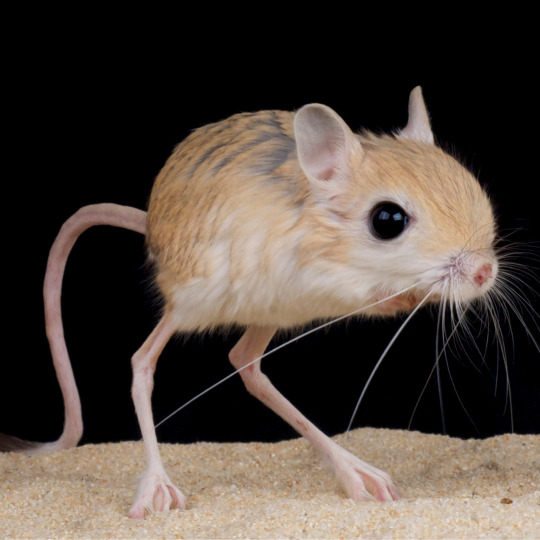
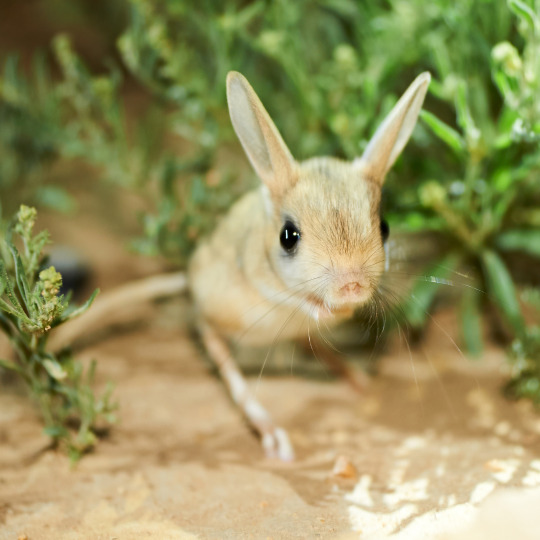
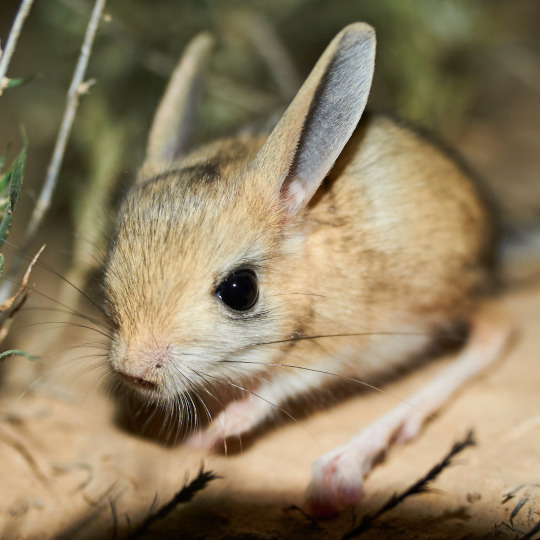

🐭 Jerboas : mysterious desert rodents 🐭
This is a Jerboa. This little mouse-like rodent is found in arid environments, such as the deserts or steppes of eastern Europe, northern Africa and east Asia.
Jerboas are often described as "miniature kangaroos". Indeed, with their very long legs, short forelimbs and a rat-like tail, these small creatures are quite the surprising sight. #NatureIsTheGreatestShow
Thanks to their impressive hind legs, these little animals can hop around at 25 kilometres per hour. When chased, they will employ a zig-zag trajectory to confuse their predator, jumping at a height of up to 1 meter vertically, and as far as 3 meter horizontally.
The Jerboa's powerful tail can be longer than their head and body: a perfect tool to keep their balance when bouncing.
Another distinctive feature of the Jerboa is its large black eyes: they are particularly well adapted to a nocturnal lifestyle and give them an excellent night vision. And with the long whiskers, these are of good use when the Jerboa wants to navigate the dark of the night, or the tunnels it lives in.
The approximately 33 species of jerboas recorded look fairly similar, but this one particularly stands out thanks to its... well... very large ears! We call them “long-eared Jerboas”.
Hopping through the deserts across northern China and southern Mongolia, long-eared Jerboas have one of the largest ear-to-body ratios in the animal kingdom, with ears that can measure up to two-thirds of their bodies. A great way to live up to their name!
This Jerboa's long ears actually act as an "organic" cooling system. As the climate in these regions can vary greatly, going from one extreme to the other. When temperatures rise, the blood moving through the ears allows the heat to dissipate from blood vessels across the skin, keeping this little rodent cool! Fascinating, isn’t it?
Fun fact, in the wild, Jerboas don't "drink" water. They get the moisture they need by munching on moist leaves, roots that they dig up, or by the insects they eat.
There is still a certain mystery surrounding Jerboas. Their nature of solitary, fearful and shy little animals, added to the remote environment in which they live, makes it very difficult to observe and study them in the wild.
[pics through Canva]
37 notes
·
View notes
Photo

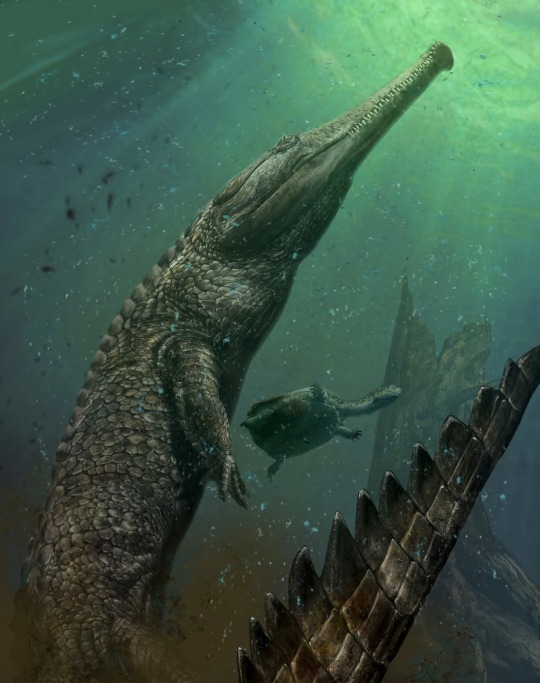
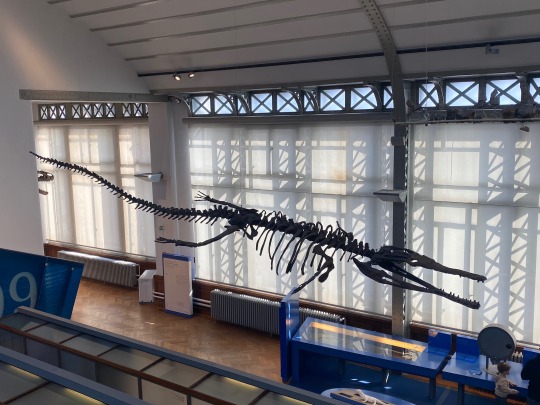
This is Machimosaurus, an impressive crocdile-like Jurassic predator from our Evolution Gallery !
Machimosaurus is a crocodyliform of the Teleosaur family, which ruled the seas and oceans from the Upper Jurassic to the Early Cretaceous.
Members of the Teleosaur family were initially more slender, with a much longer snout efficient at catching smaller preys such as fish. However, over time, Machimosaurus evolved to become particularly larger than its relatives, with a slightly shorter snout.
Semi-aquatic, Machimosaurus was able to venture ashore to hunt. However, this exceptional swimmer was a master of deep-sea hunting. In the water, it used its short legs to steer and to keep balance, while its robust tail allowed Machimosaurus to propel itself.
Other distinguishing features of this species were its massive skull and long snout. Using its conical, rounded teeth and an overpowering jaw force, Machimosaurus was able to target larger or shelled prey: fish, turtles and other marine reptiles, as well as some overly adventurous terrestrial species had to be especially cautious of this fierce predator.
Fossils of this 100-million-year-old giant have been discovered in several countries across Europe and Africa. These findings have allowed palaeontologists to separate, to this date, the lineage of Machimosaurus into five probable species.
One of these, the Machimosaurus rex recovered from a desert in Tunisia in 2016, could be the largest member of this lineage. According to various estimates, this animal could have grown up to more than 7 metres in length, for 3 tonnes: not the kind you'd want to meet in a face-off!
[Picture by visitor Merle Van Faassen, and Machimosaurus Rex illustration by Davide Bonadonna]
#naturalscience#naturalsciences#natural history#natural history museum#machimosaurus#jurassic#cretaceous#museumvisitor#naturalsciencesbrussels#royal belgian institute of natural sciences
50 notes
·
View notes
Photo



The Great Auk: the 'original' penguin
This is the Great Auk! An animal that is extinct since the 19th century.
With its distinctive white patch situated between the eyes and beak, the great auk was also the first bird to bear the name "Penguin": with "Pen" in Welsh for "Head" and "Gwyn" for "White".Sailors then continued to use the term, not only for this particular bird, but also for any other diving and flightless bird seen in the southern hemisphere: the penguins we know today!
This bird was about 75 centimeters in length and weighed some 5 kg. That's quite large in comparison to its extant relatives. The great auk could have been able to dive as deep as 70 meters, while remaining underwater for up to 15 minutes.
But their aquatic prowess may have come at the expense of their land-based abilities. Due to the placement of their legs, very far back, great auks moved very slowly once on land, which made them easy prey.To keep away from predators, great auks spent their breeding seasons on islands, gathered in large groups.
Unfortunately, this made them easy targets for hunters: these birds were sought after for their meat, as well as their skin and feathers as a resource to create objects, or their grease for lamp oil. Others were captured and used as fishing bait.
Laws were created in an attempt to save the species, but this over-hunting, added to the loss of their habitat, had caused too much damage for the population of great auks.In 1835, the last surviving colony of about 40 individuals was discovered on the Eldey Island.
At the same time, the fewer individuals left, the more valuable these animals were for rich European collectors. In 1844, the last couple of great auks was killed by a group of hunters along with their unhatched eggs, marking the end of this species.
Great Auks were already swimming along our coasts 48.000 years ago, but all that remains of them today are fossilized bones, empty eggshells and specimens kept in museums. The last male is preserved in our collections.
#natureisthegreatestshow#naturalsciences#naturalhistory#taxidermy#greatauk#naturalhistorymuseum#extinct#extinct birds#extinct animals#penguin
47 notes
·
View notes
Text
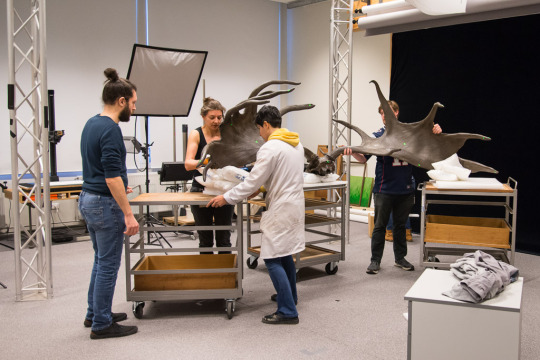
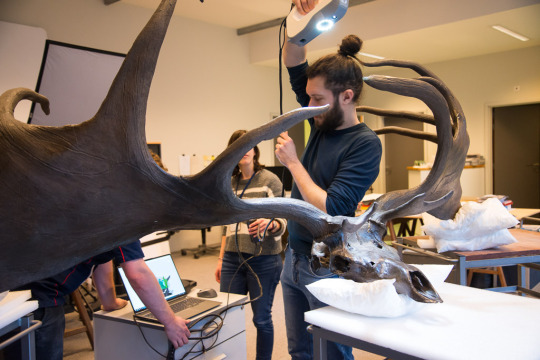



We've scanned the skull and the incredibly big antlers of Megaloceros giganteus or Irish elk! Quite a challenge, as you can see, but the result was there: a 3D version with all the details of the antlers of one of the largest cervids ever!
Irish elk lived during the same period as woolly mammoth and went extinct about 7,650 years ago.
#naturalsciencesbrussels#megaloceros#irish elk#behind the scenes#collections#natural history collections#scanning
144 notes
·
View notes
Text

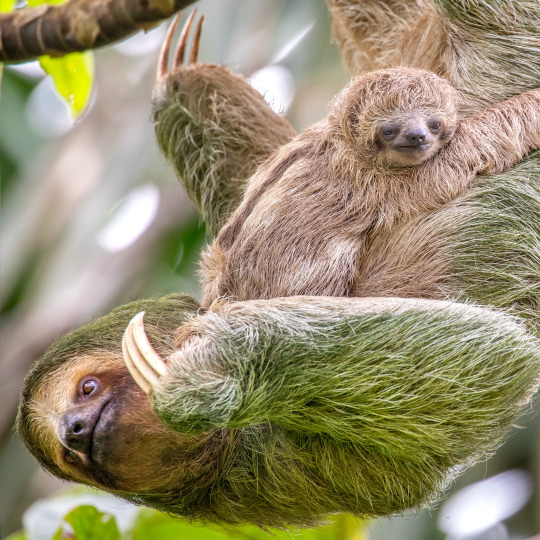
A sloth is a hanging ecosystem!
Did you know that two types of sloths exist? Sloths are identified by the number of long claws that they have on each forelimb: two or three. For example, the one in our 'Living Planet' gallery is a two-toed sloth.
Sloths move so little that different species of algae grow on their fur! These algae nourish sloth moths, some species of which exist solely on sloths... Moths that die in a sloth’s fur are digested by the fungi that also live there... And these produce substances that help algae grow... Those furry mammals are hanging ecosystems!
The algae are extra food for the sloths and they make the animals blend better with their surroundings (camouflage).
Living in the tropical rain forests in Central and South America, these sloths will spend most of their life hanging horizontally, moving along trees, and coming down once a week to… poo. They can lose up to 1/3 of their body weight by doing so! The female moths deposit eggs in the sloth's feces.
Deforestation is seriously threatening sloth populations: they are losing their habitats and are being forced to come down the trees more often, leaving them more vulnerable to predators.
[Pictures through Canva]
20 notes
·
View notes
Text
Building a dinosaur!
The famous Bernissart Iguanodons are on display at the Museum of Natural Sciences in Brussels, except for one specimen: since 2002 it's standing tall at the Musée de l'iguanodon in Bernissart. For a research and digitization project, we removed all the fossils from the metal frame in order to scan them. And then... pieced everything back together!
[Video: @rbins]
#dinosaur#dinosaurs#iguanodon#iguanodons of bernissart#naturalsciencesbrussels#dinosaur builders#dinosaur bones#mounting#behind the scenes#fossils
13 notes
·
View notes
Text
youtube
Spanish archaeologists made an unusual discovery in southern Egypt: a still undisturbed tomb containing ten mummified crocodiles. Archaeologists from the Royal Belgian Institute of Natural Sciences were able to study the mummies. ‘An extraordinary find’, says archeozoologist Bea De Cupere (RBINS). Ancient Egyptians sacrificed crocodiles during rituals to their god Sobek.
News article on our website
In 2019, archaeologists from the University of Jaén uncovered a tomb containing crocodile mummies in Qubbat al-Hawā, a site near the city of Aswan in southern Egypt. The small rock cut tomb contained five skeletons and five skulls of large crocodiles. It lies next to six other tombs in which dignitaries of the region were buried. They all date from the pre-ptolemaic era, before 304 BC.
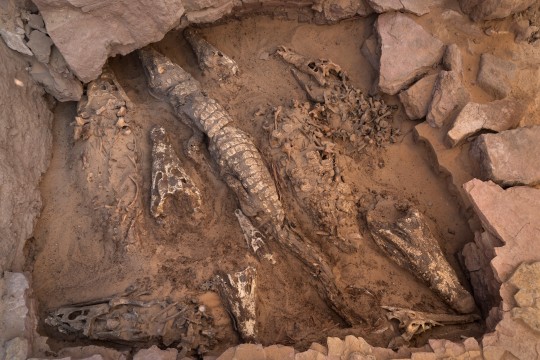
The crocodiles may have been used during rituals for the Egyptian god Sobek, the god of water and fertility, often depicted with a crocodile head. Kom Ombo, just 50 kilometres away, was an important centre for crocodile worship.
'More than 20 burial sites with crocodile mummies are known in Egypt, but to find 10 well-preserved crocodile mummies together in an undisturbed tomb is extraordinary,' says Bea De Cupere. 'Of most mummies collected by museums in the late 19th and early 20th centuries, often hatchlings, we don't know exactly where they come from.'
The archaeologists at Qubbat al-Hawā found traces of linen, palm leaves and rope, associated with some of the crocodiles, indicating that they had once been wrapped. However, the linen bandages must have rotted away, and the crocodiles weren’t covered with large amounts of pitch or bitumen, which was common in more recent periods. A happy coincidence, as this allowed the researchers to measure and study these specimens thoroughly.

Natural mummification
The smallest crocodile is 1.8 metres long, the largest 3.5 metres. They belong to two different species: the Nile crocodile and the West African crocodile. Remarkably, three skeletons were almost complete, with the other two missing quite a few parts. 'The crocodiles were first buried elsewhere, possibly in sand pits,' says De Cupere. 'This allowed the crocodiles to dry out naturally. Then the remains were unearthed, wrapped and moved to the tomb in Qubbat al-Hawā. Body parts must have been lost during wrapping and transport.'
How did the Egyptians catch these crocodiles? We know from iconography that crocodiles were caught mainly with nets. No slaughter marks have been found on the crocodiles from Qubbat al-Hawā. Possibly the crocodiles were drowned, suffocated or overheated by exposing them to the sun for long periods of time.
Stones in stomach
One crocodile was so well preserved that the gastroliths were still present. These are stones in the intestines that help crocodiles stay balanced in the water. The stones indicate that the crocodile was not cut open to take out the intestines.
‘I'm thrilled that finds like these give us another glimpse into the life of ancient Egyptians’, says De Cupere. The study appeared in the scientific journal PLOS ONE.
#discovery#crocodiles#mummies#ancient egypt#egypt#ritual#archaeology#archaeozoology#royal belgian institute of natural sciences#naturalsciencesbrussels#science news#video#Youtube
29 notes
·
View notes
Text
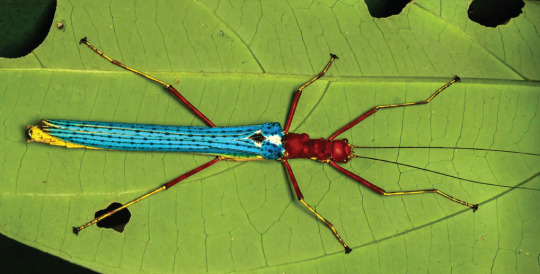



A bright blue stick insect! Stick insects are masters of camouflage, right? Well, our biologists just described a new species that didn't read the manual! #NatureIsTheGreatestShow
Why the wings are so blue and in-your-face remains a mystery for now. Possibly it signals to predators "I'm not tasty!". Indeed, these stick insects secrete a repellent substance.
It is even more fascinating: there are two types of females within this species Calvisia khlongsokana. One with blue wings and one with pale wings. This is not unusual in nature: two different types could increase the chances of survival when conditions suddenly change.
Together with colleagues our taxonomist Jérôme Constant and 'citizen scientist' Joachim Bresseel described this blue stick insect from Thailand and Myanmar. They regularly travel to Southeast Asia to find new species. It's an insect heaven that slowly reveals its secrets.
[Watch the mini documentary we made about their work]
#nature is the greatest show#naturalsciencesbrussels#insects#stick insects#entomology#taxonomy#thailand#myanmar#royal belgian institute of natural sciences
430 notes
·
View notes
Text





They look like Christmas tree decoration, these capsules of shark eggs!
Yes, certain shark species lay eggs (while others bear live young). The imprint of the capsule protecting the egg has fossilized. The basic shape of the shark is already there! The tendril on top of the egg capsule helps to hold onto structures on the seafloor.
These tiny (<4cm) fossil imprints are 320 (!) million years old. They were found in (now closed) coal mines in Belgium. By studying them our researchers identified more than 10 different species.
The egg capsule fossils in our collections witness of a high diversity in sharks spawning and nursing in ancient Belgian waters.
[Pic 1: Ronald Böttcher, State Museum of Natural History Stuttgart; Drawing: Frederik Spindler; extant shark eggs and capsules: Yohanes Wahyu Nurcahyo; B&W pictures of fossils: B. Mottequin et al. in 'The Science of Nature']
#nature is the greatest show#fossil friday#naturalsciencesbrussels#royal belgian institute of natural sciences#fossils#sharks#eggs
99 notes
·
View notes